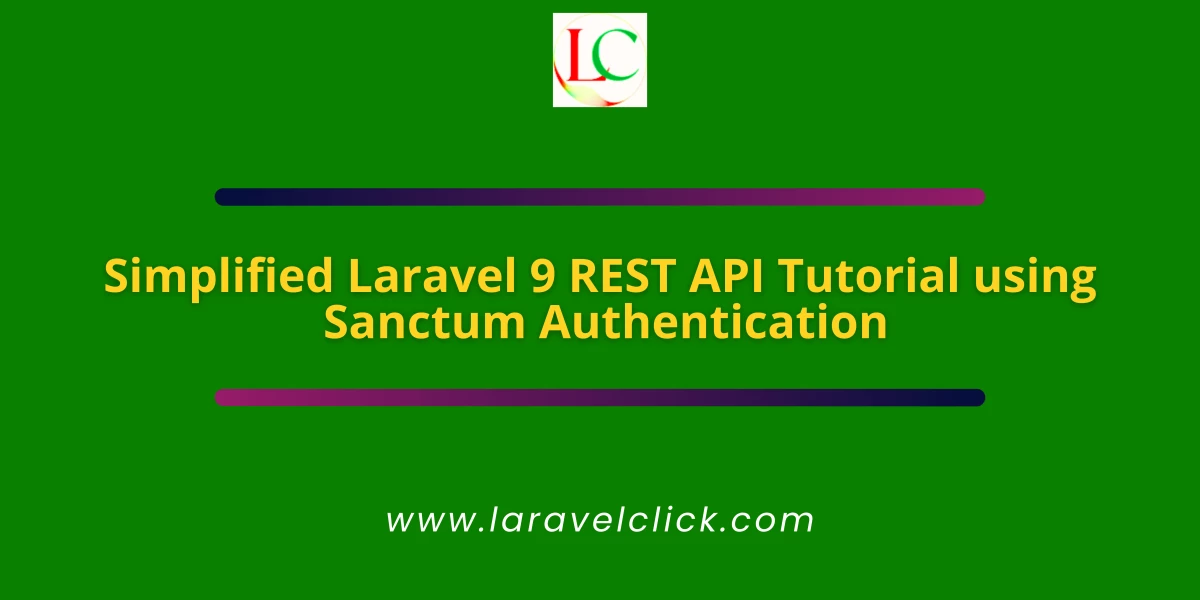Simplified Laravel 9 Cashfree Integration Tutorial for Beginners
Last Updated: 01 Feb, 2023In this awesome tutorial, we are going to learn the simplest way of integrating Cashfree Payment Gateway inside Laravel 9 application. We will be using REST APIs that have been provided by Cashfree.
Cashfree is a powerful and scalable payments platform that has been designed for business payment needs. It provides the following services which are very easy to use:
- Helps to Collect Online Payments
- Provides Multiple Channels
- Helps to Send Payouts
- Allows Easy Reconcilation
- Offers Recurring Payments
- Allows to manage International Payments and do more.
Simplest way to integrate Cashfree Payment Gateway in Laravel 9 application?
Hi friends, I am feeling very excited to share my experience of integrating cashfree in laravel application. Just follow the below mentioned steps to get this done.
Step 1: Create New Laravel 9 Application
At first, let's create a new laravel 9 application by running below command in your terminal:
composer create-project laravel/laravel l9cashfreepg
Step 2: Update .env file for DB Connection
Next, let's modify .env file and provide your database credentials as follows:
DB_DATABASE=l9cashfreepg
DB_USERNAME={your_dbuser}
DB_PASSWORD={your_dbpass}
Step 3: Setup Cashfree API KEYs and Endpoint
Now, let's go to cashfree official website (https://www.cashfree.com/) and login to your account. If you have not created your cashfree account yet, create a new account. Then, you can get your API_KEY and API_SECRET. Let's configure these credentials in .env file as follows:
CFPG_API_KEY=dfsd706e124dfk7wea3099edrt4784
CFPG_API_SECRET=a178dfk7wea35def32f3350ab32f2ab5706e124
CFPG_ENDPOINT=https://test.cashfree.com/
Next, open your app/config/services.php file and copy the following code inside it:
'cashfree' => [
'api_key' => env('CFPG_API_KEY'),
'api_secret' => env('CFPG_API_SECRET'),
'endpoint' => env('CFPG_ENDPOINT')
],
Step 4: Create CFPGPayment Model & Migration
Next, you have to create model and migration files to store payment details inside it. Execute below given command in the therminal:
php artisan make:model CFPGPayment
php artisan make:migration create_cfpgpayments_table
Above command will generate a model and a migration file. Open app/Models/CFPGPayment.php file and copy below provided code into it:
<?php
namespace App\Models;
use Illuminate\Database\Eloquent\Factories\HasFactory;
use Illuminate\Database\Eloquent\Model;
class CFPGPayment extends Model
{
use HasFactory;
protected $fillable = [
'name',
'email',
'mobile',
'amount'
];
}
Open the databse/migrations/*_create_cfpgpayments_table.php file and copy below mentioned code into it:
<?php
use Illuminate\Database\Migrations\Migration;
use Illuminate\Database\Schema\Blueprint;
use Illuminate\Support\Facades\Schema;
return new class extends Migration
{
public function up()
{
Schema::create('cfpgpayments', function (Blueprint $table) {
$table->id();
$table->string('name');
$table->string('mobile');
$table->string('email');
$table->string('amount');
$table->string('purpose');
$table->string('payment_request_id');
$table->string('payment_link');
$table->string('payment_status');
$table->string('payment_id')->nullable();
$table->timestamps();
});
}
public function down()
{
Schema::dropIfExists('cfpgpayments');
}
};
Next, execute the below command to run laravel migrattion that will create the tables in the mysql db:
php artisan migrate
Step 5: Create Application Routes
Next, open the routes/web.php file and copy the following code inside it:
<?php
use Illuminate\Support\Facades\Route;
use App\Http\Controllers\CFPGPaymentController;
Route::group(['prefix' => 'cashfreepayments'], function () {
Route::get('/', [CFPGPaymentController::class, 'index']);
Route::get('/create', [CFPGPaymentController::class, 'create']);
Route::post('/', [CFPGPaymentController::class, 'store']);
Route::any('/success', [CFPGPaymentController::class, 'success']);
});
Step 6: Create CFPGPayment Controller
php artisan make:controller CFPGPaymentController
Next, let's create a controller app/Http/Controllers/CFPGPaymentController.php file and copy below given code in it:
<?php
namespace App\Http\Controllers;
use Illuminate\Http\Request;
use Illuminate\Support\Str;
use Validator;
use App\Models\CFPGPayment;
class CFPGPaymentController extends Controller
{
protected $rpp = 10;
public function index(Request $request)
{
$request_data = $request->all();
$view_data = [];
if (!$request->ajax()){
$view_data['title'] = 'Payment List';
return view('cfpgpayments.index')->with($view_data);
} else {
$page = $request_data['page'];
$view_data['page'] = $page;
$records = CFPGPayment::orderBy('created_at', 'desc')->paginate($this->rpp);
$record_starts = $this->rpp * ($page - 1) + 1;
$record_ends = $this->rpp * ($page - 1) + count($records);
$view_data['records'] = $records;
$view_data['record_starts'] = $record_starts;
$view_data['record_ends'] = $record_ends;
return view('cfpgpayments.list')->with($view_data);
}
}
public function create(Request $request)
{
$view_data['title'] = 'Create New Payment';
return view('cfpgpayments.payments.create')->with($view_data);
}
public function store(Request $request)
{
$posted_data = $request->all();
$validator = Validator::make($posted_data, array(
'name' => 'required|min:3',
'email' => 'required',
'mobile' => 'required',
'amount' => 'required'
), array(
'name.required' => 'Enter your name.',
'name.min' => 'Name must be min of 3 characters.',
'email.required' => 'Enter your email address.',
'mobile.required' => 'Enter your mobile number.',
'amount.required' => 'Enter your amount.'
));
if ($validator->fails()) {
return redirect()->back()->withInput($request->only('name', 'email', 'mobile', 'amount'))->withErrors($validator->errors());
}
try {
$cashfree = config('services.cashfree');
$name = trim($request->name);
$email = trim($request->email);
$mobile = trim($request->mobile);
$amount = intval($request->amount);
$purpose = 'Cashfree Invoice Payment';
$payload = array(
'appId' => $cashfree['api_key'],
'secretKey' => $cashfree['api_secret'],
'orderId' => 'CFORDER-' . Str::random(9),
'orderAmount' => $amount,
'orderCurrency' => 'INR',
'orderNote' => $purpose,
'customerName' => $name,
'customerPhone' => $mobile,
'customerEmail' => $email,
'returnUrl' => url('/cashfreepayments/success')
);
$request_string = "";
foreach($payload as $key=>$value) {
$request_string .= $key.'='.rawurlencode($value).'&';
}
$end_point = $cashfree['endpoint'];
$opUrl = $end_point . "api/v1/order/create";
try {
$ch = curl_init();
curl_setopt($ch, CURLOPT_URL, "$opUrl?");
curl_setopt($ch, CURLOPT_POST, count($payload));
curl_setopt($ch, CURLOPT_POSTFIELDS, $request_string);
curl_setopt($ch, CURLOPT_RETURNTRANSFER, 1);
curl_setopt($ch, CURLOPT_TIMEOUT, 60);
$curl_result=curl_exec ($ch);
curl_close ($ch);
$response = json_decode($curl_result);
if ($response->{'status'} == "OK") {
$paymentLink = $response->{"paymentLink"};
CFPGPayment::insert([
'name' => $name,
'email' => $email,
'mobile' => $mobile,
'amount' => $amount,
'purpose' => $purpose,
'payment_request_id' => $cf_request["orderId"],
'payment_link' => $paymentLink,
'payment_status' => 'created',
'created_at' => now(),
'updated_at' => now()
]);
header('Location: ' . $paymentLink);
exit();
} else {
echo "<pre>";
print_r($response);
exit;
}
} catch (Exception $e) {
$return_data = array(
'status' => 'ERROR',
'message' => $e->getMessage()
);
}
}catch (Exception $e) {
echo "<pre>";
print('Error: ' . $e->getMessage());
exit;
}
}
public function success(Request $request)
{
$request_data = $request->all();
$payment_id = $request_data['referenceId'];
$payment_status = trim($request_data['txStatus']);
$payment_request_id = $request_data['orderId'];
$cf_payment = CFPGPayment::where('payment_request_id', $payment_request_id)->first();
if (strtolower($payment_status) == 'success') {
$cf_payment->payment_status = $payment_status;
$cf_payment->payment_id = $payment_id;
$cf_payment->save();
dd('Payment Successful');
} else {
dd('Payment Failed!');
}
dd($request_data);
}
}
Step 7: Create Blade View Pages
Now, create the following blade files under resources/views/cfpgpayments directory:
resources/views/cfpgpayments/index.blade.php
<!DOCTYPE html>
<html>
<head>
<meta charset="utf-8">
<title>Cashfree Payment Gateway Integration Tutorial - Laravel 9</title>
<meta name="csrf-token" content="{{ csrf_token() }}">
<link href="https://cdn.jsdelivr.net/npm/bootstrap@5.1.3/dist/css/bootstrap.min.css" rel="stylesheet">
<script src="https://cdn.jsdelivr.net/npm/jquery@3.6.0/dist/jquery.min.js"></script>
</head>
<body>
<div class="container mt-3">
<div class="row text-center"><h1>Cashfree Payment Gateway Integration Tutorial in Laravel 9</h1></div>
<div class="row" id="result-div"><strong style="color: #0cf;text-align: center;">Fetching payments...</strong></div>
</div>
<script>
var pageNo = 1;
$(document).ready(function(){
$.ajax({
url: "{{url('cashfreepayments')}}",
type: "GET",
dataType: "HTML",
data: { 'page': pageNo }
}).done(function(data){
$("#result-div").empty().html(data);
}).fail(function(jqXHR, ajaxOptions, thrownError){
console.log('No response from server');
}).always(function(){
});
});
</script>
</body>
</html>
resources/views/cfpgpayments/list.blade.php
<div class="col-12 mb-3">
<div class="card text-white bg-success mb-3">
<div class="card-header">
<h3 class="card-title" style="display: inline-block;">Payments List</h3>
<a href="{{url('/cashfreepayments/create')}}" class="btn btn-primary float-end">Create New Payment</a>
</div>
<div class="card-body table-responsive">
<table class="table table-striped text-white">
<thead>
<tr style="text-transform: uppercase;">
<th>#</th>
<th>Name</th>
<th>EMail</th>
<th>Mobile</th>
<th>Amount</th>
<th>Purpose</th>
<th>Status</th>
<th>PaymentId</th>
<th>CreatedAt</th>
</tr>
</thead>
<tbody>
@if($records->count() > 0)
@foreach($records as $rec)
<tr>
<td>{{$loop->iteration}}</td>
<td>{{$rec->name}}</td>
<td>{{$rec->email}}</td>
<td>{{$rec->mobile}}</td>
<td>{{$rec->amount}}</td>
<td>{{$rec->purpose}}</td>
<td><button class="btn btn-info">{{$rec->payment_status}}</button></td>
<td>{{$rec->payment_id}}</td>
<td>{{$rec->created_at}}</td>
</tr>
@endforeach
@else
<tr class="text-center"><td colspan="8">Record not found!!</td></tr>
@endif
</tbody>
</table>
{!! $records->links() !!}
</div>
</div>
</div>
resources/views/cfpgpayments/create.blade.php
<!DOCTYPE html>
<html>
<head>
<meta charset="utf-8">
<title>Cashfree Payment Gateway Integration Tutorial - Laravel 9</title>
<meta name="csrf-token" content="{{ csrf_token() }}">
<link href="https://cdn.jsdelivr.net/npm/bootstrap@5.1.3/dist/css/bootstrap.min.css" rel="stylesheet">
</head>
<body>
<div class="container mt-3">
<div class="row justify-content-center">
<div class="col-12 col-md-6 mb-3">
<div class="card text-dark bg-success mb-3">
<div class="card-header">
<h3 class="card-title text-white" style="display: inline-block;">Create New Payment</h3>
<a href="{{url('/cashfreepayments')}}" class="btn btn-primary float-end">Payments List</a>
</div>
<div class="card-body">
<form action="{{ url('cashfreepayments') }}" method="POST" name="laravel9-cashfree-integration">
{{ csrf_field() }}
<div class="form-floating">
<input type="text" class="form-control" name="name" id="name" value="{{ old('name') }}" placeholder="name">
<label for="name">Full Name</label>
</div>
<div class="form-floating">
<input type="email" class="form-control" name="email" id="email" value="{{ old('email') }}" placeholder="email">
<label for="email">Email Address</label>
</div>
<div class="form-floating">
<input type="text" class="form-control" name="mobile" id="mobile" value="{{ old('mobile') }}" placeholder="mobile">
<label for="mobile">Mobile Number</label>
</div>
<div class="form-floating">
<input type="text" class="form-control" name="amount" id="amount" value="{{ old('amount') }}" placeholder="amount">
<label for="amount">Amount</label>
</div>
<button class="w-100 btn btn-lg btn-primary" type="submit">Place Order</button>
</form>
@if ($errors->any())
<div class="alert alert-danger text-start" role="alert">
<strong>Opps!</strong> Something went wrong<br>
<ul>
@foreach ($errors->all() as $error)
<li>{{ $error }}</li>
@endforeach
</ul>
</div>
@endif
</div>
</div>
</div>
</div>
</div>
</body>
</html>
Step 8: Run Your Application
All set, let's start the development server now by executing below command in your terminal:
php artisan serve
Once development server is started, in your browser, open below URL:
http://127.0.0.1:8000/cashfreepayments
Note: Test Card Credentials link to test your application:
Recommended Posts

Simplified Laravel 9 REST API Tutorial using Sanctum Authentication
In this simplified tutorial, you will learn the simplest way to create a REST API application in Laravel 9 that will be authenticated using Laravel Sanctum.

Simplified Laravel 9 Razorpay Integration Tutorial for Beginners
This simplified tutorial will show you the easy and simplest way of integrating Razorpay Payment Gateway in Laravel 9 Application.

Simplified Laravel 9 Instamojo Integration Tutorial for Beginners
In this simple tutorial, you will be learning the easy and comprehensive way of integrating Instamojo Payment Gateway inside Laravel 9 application.